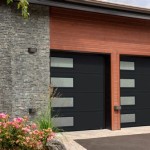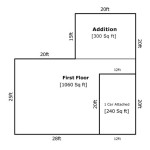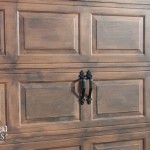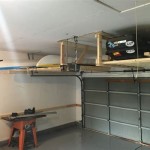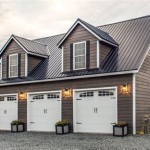How To Paint A Garage Door With A Brushed Nickel Finish
Achieving a brushed nickel finish on a garage door involves a multi-step process requiring careful preparation and application. This sophisticated look can significantly enhance curb appeal, offering a modern and elegant aesthetic. This guide outlines the necessary steps to achieve professional-looking results.
1. Preparing the Garage Door Surface
Proper surface preparation is crucial for a successful and long-lasting finish. Begin by thoroughly cleaning the garage door to remove dirt, grime, and any existing loose paint. A pressure washer can be highly effective for this, but a garden hose and scrub brush also suffice. Allow the door to dry completely before proceeding.
If the existing paint is peeling or chipping, use a scraper or wire brush to remove these loose flakes. For particularly stubborn areas, a chemical paint stripper may be necessary, following the manufacturer’s instructions carefully. Any rust present should be sanded down to bare metal using sandpaper or a wire brush. A rust converter primer can be applied to these areas to prevent future rust formation. Fill any dents or imperfections with an appropriate exterior-grade filler, allowing it to dry and then sanding smooth.
Next, lightly sand the entire surface of the garage door to create a slightly rough texture that will promote better paint adhesion. Use a fine-grit sandpaper (around 220-grit) and wipe down the door with a tack cloth to remove all sanding dust.
Finally, mask off any areas that should not be painted, such as windows, trim, and handles, using painter's tape and masking paper or plastic sheeting. This meticulous masking will ensure clean lines and a professional finish.
2. Priming the Garage Door
Priming the garage door is an essential step, especially when working with metal surfaces or if a significant color change is involved. Primer provides a uniform base for the topcoat, improving adhesion and color consistency. Choose a high-quality exterior-grade primer specifically designed for metal surfaces. A bonding primer is recommended if working with galvanized steel or aluminum.
Apply the primer evenly using a brush, roller, or paint sprayer, following the manufacturer’s instructions regarding drying time between coats. A thin, even coat is preferable to a thick, uneven one, as this will prevent drips and ensure proper drying. For best results, apply two coats of primer, allowing each coat to dry completely before applying the next.
3. Applying the Brushed Nickel Finish
Achieving the brushed nickel look typically involves using metallic paint designed specifically for this purpose. These paints are often formulated with real metal particles to create the desired shimmer and texture. There are several options available, including spray paint, brush-on paint, and specialized kits.
If using spray paint, apply several thin coats, holding the can about 10-12 inches from the surface and using a sweeping motion to ensure even coverage. Overlapping each pass slightly will prevent streaks. Allow each coat to dry completely before applying the next.
If using brush-on paint, apply the paint in long, even strokes, working in the direction of the brushed nickel grain you wish to achieve. This will help create the characteristic brushed texture. Multiple coats may be necessary to achieve the desired opacity and sheen. Allow each coat to dry thoroughly before applying the next.
Specialized kits often include a base coat and a topcoat that is brushed on and then manipulated with a special tool to create the brushed effect. Follow the manufacturer’s instructions carefully for these kits to achieve the best results.
Regardless of the chosen method, patience and attention to detail are key. Take your time and work systematically to ensure even coverage and a consistent finish.
4. Sealing the Finish (Optional)
While optional, applying a clear sealant over the brushed nickel finish can provide added protection against the elements and enhance the longevity of the finish. Choose a high-quality exterior-grade clear coat specifically designed for metal surfaces. Apply the sealant in thin, even coats, allowing each coat to dry completely before applying the next. This step will protect the paint from UV damage, moisture, and general wear and tear.
Once the final coat is dry, carefully remove the painter's tape and masking paper. This should be done while the paint is still slightly pliable to prevent pulling up any of the new finish. Admire your newly refinished garage door with its stylish brushed nickel finish.

How To Paint New Metal Garage Door With A Brush And Roller

Faux Wood Doors One Project A Weekend Love Paper Paint
:strip_icc()/UrbaneBronzeSW-4d198ac48d4d4fe38ede9915413de88e.jpg?strip=all)
11 Best Paint Colors For Garage Doors
11 Best Paint Colors For Garage Doors

How To Paint New Metal Garage Door With A Brush And Roller

How To Make A Plain Garage Door Look Like Carriage Style
11 Best Paint Colors For Garage Doors

Recessed Panel Garage Doors C H I Overhead

How To Paint New Metal Garage Door With A Brush And Roller

The Best Way To Spray Paint Door Knobs That Last 2025
Related Posts



